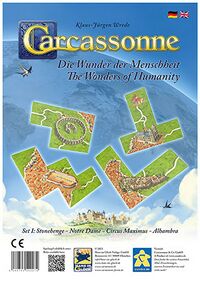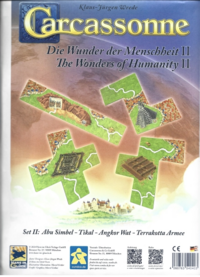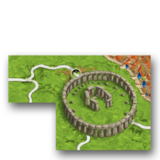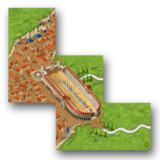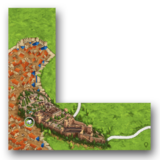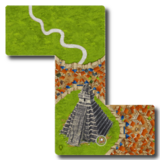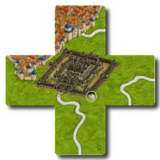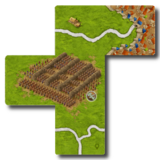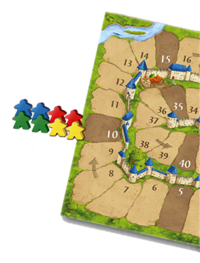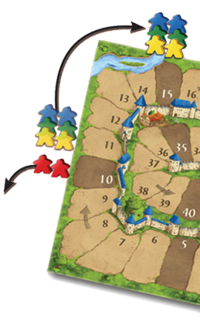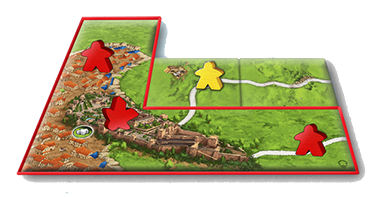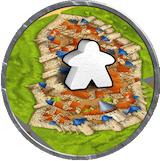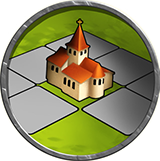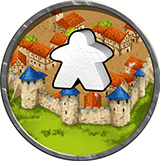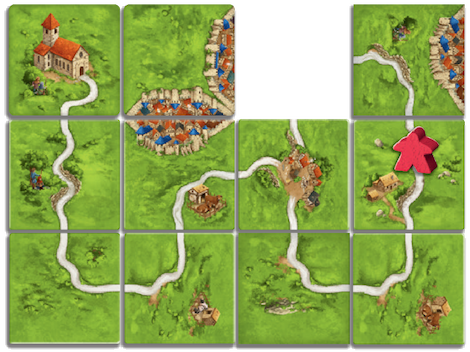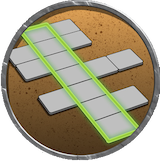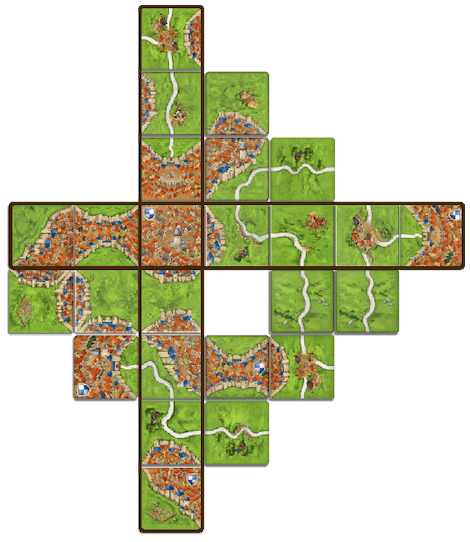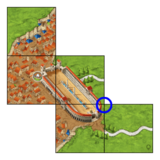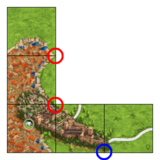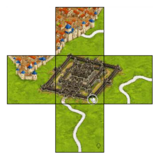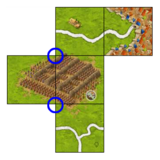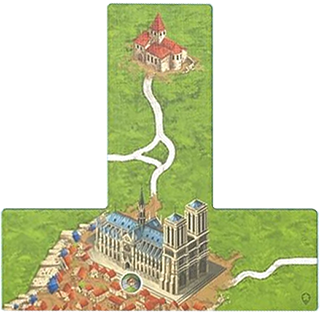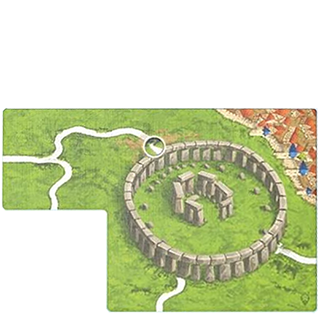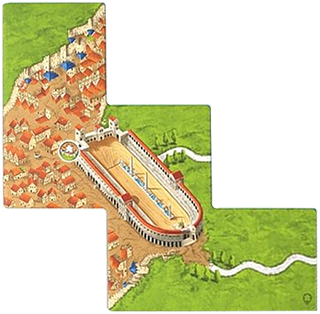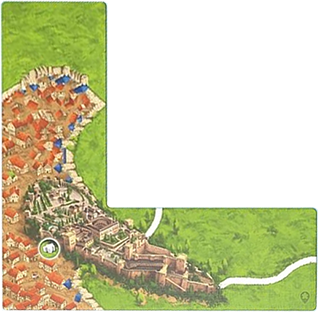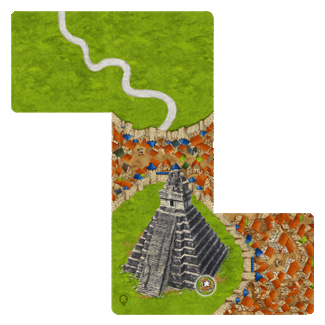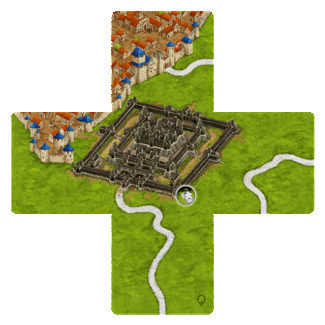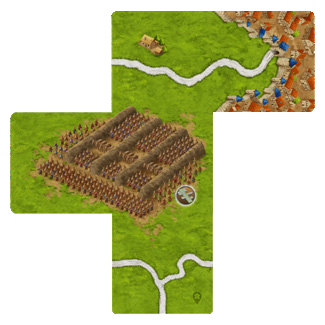Les Merveilles de l’Humanité
 |
Vous êtes en train de lire les règles pour ce modèle de tuiles. |
| Cette extension n’a pas été publiée dans d’autres éditions. |
| Si vos tuiles ont un motif différent, choisissez un jeu parmi les jeux dérivés. |  |

L’extension Les Merveilles de l’Humanité contient des mégas tuiles qui s’étendent sur 5 carrés dans différentes configurations. Chaque méga tuile représente une merveille construite par l’homme à différentes époques. Chacune d’entre elles vous apporte des avantages individuels. Mais chacun ne peut en utiliser qu’une seule par partie. Obtenez rapidement la merveille qui vous convient pour en profiter au maximum !
Les Merveilles de l’Humanité ont fait leur entrée à Carcassonne. Chacune d’entre elles vous apporte des avantages individuels. Mais chacun ne peut en utiliser qu’une seule par partie. Obtenez rapidement la merveille qui vous convient pour en profiter au maximum !
Informations générales et commentaires
Les Merveilles de l’Humanité a été publié par Hans im Glück en 2023 (série 1) et 2024 (série 2). L’extension contient des tuiles Merveille qui s’étendent sur 5 carrés dans différentes configurations. Chaque tuile représente une merveille construite par l’homme à différentes époques.
La première série contient les merveilles suivantes :
- Stonehenge, un monument préhistorique situé près d’Amesbury, dans le sud de l’Angleterre (Royaume-Uni).
- Circus Maximus, un ancien stade romain de courses de chars et un lieu de divertissement populaire situé à Rome, en Italie.
- Notre-Dame, une cathédrale médiévale gothique construite à Paris, en France.
- Alhambra, complexe de palais et de forteresses datant du XIIIᵉ siècle situé à Grenade, en Espagne.
La deuxième série contient les merveilles suivantes :
- Abou Simbel, deux temples rupestres construits en Égypte au XIIIᵉ siècle avant Jésus-Christ.
- Tikal, une ancienne cité maya située dans le nord du Guatemala.
- Angkor Vat, un complexe de temples du Xᵉ siècle au Cambodge.
- L'armée de terre cuite, plus de 7000 soldats grandeur nature dans un complexe funéraire de la Chine ancienne.
Cette extension comporte des villes avec des bâtiments coupés.
Remarque : Toutes les tuiles Merveille comptent comme 5 tuiles Terrain connectées.
Matériel
Série 1
- 4 tuiles Merveille représentant des merveilles de l’humanité
Remarque : La carte imprimée au dos de la première série de tuiles Merveille (Stonehenge, Notre-Dame, Circus Maximus et Alhambra) n’était pertinente que lors du Festival des Jeux Carcassonne de 2023 à Carcassonne.
Série 2
- 4 tuiles Merveille représentant des merveilles de l’humanité
Règles
Mise en place
Nous vous recommandons de jouer avec au moins 90 tuiles et un meeple supplémentaire (par exemple, jeu de base + 1ʳᵉ extension) [1]. Vous ignorez les règles des extensions supplémentaires.
- Pour marquer votre merveille plus tard, nous vous conseillons de prendre un autre meeple (marqueur) de votre couleur. Vous pouvez également utiliser un autre objet de votre couleur comme marqueur [2].
- Comme toujours, placez un meeple de chaque couleur sur le plateau de score en tant que meeple de score.
- Placez un autre meeple de chaque couleur + le meeple marqueur à côté de la case 10 à l’extérieur du plateau de score. Chaque joueur commence la partie avec 6 meeples dans sa réserve.
- Sélectionnez autant de merveilles qu’il y a de joueurs et placez-les face visible à côté du plateau de score. Mettez les autres merveilles de côté pour de prochaines parties.
Remarque : Vous pouvez également préparer autant de merveilles que vous le souhaitez. Vous aurez alors un plus grand choix de merveilles et vous pourrez choisir celle qui vous convient le mieux, plus tard dans le jeu.
Placement d’une tuile Merveille
Chaque joueur peut disposer d’une merveille. Pour recevoir une tuile Merveille, vous devez remplir la condition relevant de la section 3. Évaluation des zones décrite ci-dessous :
3. Évaluation des zones et obtention d’une tuile Merveille
Il y a une merveille par joueur. Vous ne pouvez donc obtenir une tuile Merveille qu’une seule fois au cours de la partie (Pour une variante avec deux merveilles par joueur, voir ci-dessous).
Lorsque votre meeple de score atteint ou dépasse la case avec les deux meeples (la première fois, il s’agit de la case 10), vous effectuez les étapes suivantes dans cet ordre :
- Choose one of the wonder tiles available and place it in front of you. You don't place it on the game board yet (see 1. Placing a wonder tile).
- Take your two meeples next to the scoreboard and add them to your supply.
- Move all remaining meeples placed next to the scoreboard 5 spaces forward (i.e. the first time next to the 15 space, then next to the 20 space, and finally next to the 25 space).
Attention: You must never move the meeple pairs beyond the 25 space, even if there are more than 4 players. The meeples remain next to the 25 space until they are reached by all other scoring meeples.
Cas particuliers
1. Placement d’une tuile Merveille
Si vous possédez une merveille devant vous, vous ne piochez pas de tuile, mais vous placez votre merveille selon les règles habituelles. Une fois que vous l’avez placée, vous marquez votre merveille avec votre meeple marqueur en le posant au centre de la merveille (pas dans une ville, sur une route ou dans un pré).
Remarque : Si vous utilisez des meeples normaux, vous pouvez les poser à l’envers pour les distinguer des autres meeples. Ainsi, vous ne les confondrez pas avec des chevaliers, des voyageurs ou des paysans [3]. Le meeple marqueur reste en place jusqu’à la fin de la partie.
2. Pose d’un meeple sur une tuile Merveille
Après avoir posé et marqué votre merveille, vous pouvez immédiatement poser jusqu’à 2 meeples sur différentes zones inoccupées (ville, route, abbaye ou pré) de cette tuile Merveille. Vous pouvez également ne poser qu’un seul meeple ou aucun meeple.
3. Évaluation d’une merveille
Chaque merveille a sa propre fonctionnalité qui peut vous faire gagner des points. Certaines merveilles rapportent des points en cours de partie, d’autres lors de l’évaluation finale (peut-être les deux pour des merveilles futures). À partir du tour où vous placez et marquez votre merveille, vous pouvez l’utiliser pour marquer des points.
![]() Question : Do you get the Stonehenge bonus if you complete an unoccupied road and then you add a meeple to it on the tile just placed?
Question : Do you get the Stonehenge bonus if you complete an unoccupied road and then you add a meeple to it on the tile just placed?
Réponse : Yes it is possible. You place the meeple in 2. Placing a meeple right before you perform 3. Scoring with a wonder. (3/2024)
When it's your turn, you can choose from 2 tiles. The first time you draw 2 tiles. You choose one and place it as usual. Place the other one face down in front of you for a later turn. When it's your turn again, you draw another tile and choose from 2 tiles again, and so on. If there are no more tiles for you to draw at the end of the game, place the one in front of you. If your unchosen tile is the last one in the game, it goes to the next player for the last turn.
If a city is scored that is at least 3 tiles in size and in which you have at least one meeple, you receive 2 points for each of your own meeples in a city on the board. The following applies:
- You do not have to have the majority in the scored city.
- The meeple in the scored city also scores 2 points.
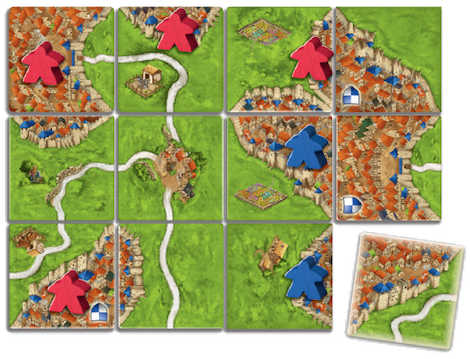
For each road (incomplete or complete) that is at least 5 tiles long, you receive 5 points at the end of the game.
You receive 2 points for every 7+ tiles that are in a row or column on the board at the end of the game. The following applies:
- You may score identical tiles for the column and for the row.
- Each column and row is only scored once.
Important !
- Lors de l’évaluation finale, vous évaluez toujours en premier les merveilles qui marquent des points en fin de jeu, avant de poursuivre avec l’évaluation finale habituelle.
- Notre-Dame et Stonehenge, possèdent également une route plus longue d’une longueur de 2 tuiles « normales ». Cette route est considérée comme 2 tuiles Route pour le décompte des points [4].
|finalscoring=
At the end of the game, you first score the wonders that score at the end of the game. After that, you continue with the normal final scoring. [5]
}}
 Variante - 2 merveilles par joueur
Variante - 2 merveilles par joueur
If you are already familiar with this expansion, you can also try out the following variant, in which each player receives up to 2 wonders in the game. You now receive the effects of both wonders. Depending on the situation, you can also build interesting combinations.
Note: All the rules of the game remain the same. We are only listing changes here.
Mise en place
We recommend that you play with at least 120 or more tiles and 2 additional meeples (e.g. base game + river + 1st expansion and any other tiles from (mini) expansions). But ignore the expansion rules.[6]
- Each player takes 10 meeples of one color. Place 2 meeples of each color next to space 10 outside the scoring board, and 1 meeple next to the 0/50 starting space.
- Choose 2 or any number of wonders per player and place them next to the scoring board.
Receive the second wonder tile
If your counting meeple reaches or exceeds the 50 space, you choose your second wonder, place it in front of you and take the meeple next to the 0/50 starting space. After that, you use it to mark your second wonder on your next turn, after you have placed it.
Précisions supplémentaires
Roads, cities and fields on wonder tiles
![]() Some wonder tiles include multiple cities spreading across multiple square spaces. Each space should be counted like a separate tile. The following images illustrate the number of road and city tiles to consider for each wonder tile as well as the intended field connectivity. Blue circles represent connected fields and red circles represent separated fields.
Some wonder tiles include multiple cities spreading across multiple square spaces. Each space should be counted like a separate tile. The following images illustrate the number of road and city tiles to consider for each wonder tile as well as the intended field connectivity. Blue circles represent connected fields and red circles represent separated fields.
Notes:
- The dirt patches next to some wonders are part of the wonder, not part of the adjacent city.
- The die-cutting of the wonder tiles may affect field connectivity due to production variations. If playing with wonder tiles diverging from the intended field connectivity, players will have to agree on the field connectivity to apply.
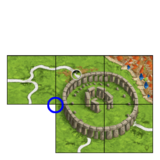 |
Stonehenge
|
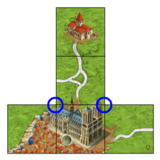 |
Notre-Dame
|
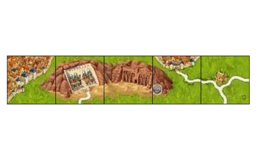 |
Abu Simbel
|
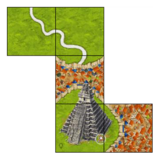 |
Tikal
|
![]() Question : Does the city on the Notre-Dame wonder tile span 2 or 4 tiles? The dirt patches surrounding Notre-Dame extend to 2 adjacent square spaces (top and right). It is a bit ambiguous in visual terms, since there is no actual wall closing the city but the houseless dirt patches with Notre-Dame bordering the field.
Question : Does the city on the Notre-Dame wonder tile span 2 or 4 tiles? The dirt patches surrounding Notre-Dame extend to 2 adjacent square spaces (top and right). It is a bit ambiguous in visual terms, since there is no actual wall closing the city but the houseless dirt patches with Notre-Dame bordering the field.
Réponse : The city only spans across 2 tiles. The dirt patches surrounding Notre-Dame are graphically necessary to close off the roads there. (3/2024)
![]() Question : The outer stone circle limits the surrounding fields, so there are 4 fields on the Stonehenge wonder tile. Is this correct?
Question : The outer stone circle limits the surrounding fields, so there are 4 fields on the Stonehenge wonder tile. Is this correct?
Réponse : It is exactly right. (3/2024)
![]() A farmer placed in a field only bordering a wonder but not the city adjacent to the wonder will not score points for this city. This may happen to some fields on wonder tiles:
A farmer placed in a field only bordering a wonder but not the city adjacent to the wonder will not score points for this city. This may happen to some fields on wonder tiles:
- The field surrounding the monastery on the Notre-Dame wonder tile (top right)
- The field between the roads on the Circus Maximus wonder tile (center right)
- The field between the roads on the Alhambra wonder tile (center right)
Note that wonders (including the dirt patches next to them) are separate features from cities. Wonders limit cities but are not part of them.
![]() Question : Some wonders such as Notre-Dame, Circus Maximus and Alhambra include a field between two roads that touches the wonder. Is this field considered to touch the city or only the wonder (and therefore no city)?
Question : Some wonders such as Notre-Dame, Circus Maximus and Alhambra include a field between two roads that touches the wonder. Is this field considered to touch the city or only the wonder (and therefore no city)?
Réponse : The field only touches the wonder. A wonder is always neutral and not part of a city. (3/2024)
Monasteries and wonder tiles
Autres extensions
Cette section contient des informations supplémentaires sur les interactions avec les autres extensions de Carcassonne.
![]() You may place 0, 1 or 2 wooden meeples on a wonder tile. This is one single action.
You may place 0, 1 or 2 wooden meeples on a wonder tile. This is one single action.
- If you only place one wooden meeple, you cannot perform any other action instead of placing the second wooden meeple. [7]
- If you only place one or two wooden meeples, you may use direct placement and even another placement mechanic available for one of the meeples: "Add Meeple" / "Place Meeple" (
 Extension du 20ᵉ anniversaire).
Extension du 20ᵉ anniversaire).
![]() The wooden meeples that can be placed on the wonder tile are the following:
The wooden meeples that can be placed on the wonder tile are the following:
![]() After placing 0, 1 or 2 wooden meeples on the wonder tile, you may place:
After placing 0, 1 or 2 wooden meeples on the wonder tile, you may place:
![]() All monastic buildings can trigger the Notre-Dame bonus when placing a meeple on an adjacent tile:
All monastic buildings can trigger the Notre-Dame bonus when placing a meeple on an adjacent tile:
- Abbaye (
 Jeu de base)
Jeu de base) - Monastère (
 Ext. 5 – Maires et Monastères)
Ext. 5 – Maires et Monastères) - Lieu de culte (
 Ext. 6 – Comte, Roi et Brigand)
Ext. 6 – Comte, Roi et Brigand) - German monastery (
 Abbayes d’Allemagne)
Abbayes d’Allemagne) - Dutch & Belgian monastery (
 Abbayes des Pays-Bas et de Belgique)
Abbayes des Pays-Bas et de Belgique) - Monument japonais (
 Monuments japonais)
Monuments japonais) - Église de Darmstadt (
 Tuiles promotionnelles Darmstadt Spielt)
Tuiles promotionnelles Darmstadt Spielt)
![]() The following features do not trigger the Notre-Dame bonus when placing a meeple on an adjacent tile:
The following features do not trigger the Notre-Dame bonus when placing a meeple on an adjacent tile:
- Jardin (Jeu de base -
 L’Abbé)
L’Abbé) - Cathédrale allemande (
 Cathédrales d’Allemagne)
Cathédrales d’Allemagne)
![]() If you place a wooden meeple on the wonder tile, you cannot remove your abbot instead of placing a second wooden meeple.
If you place a wooden meeple on the wonder tile, you cannot remove your abbot instead of placing a second wooden meeple.
![]() A garden does not trigger the Notre-Dame bonus when placing a meeple on an adjacent tile.
A garden does not trigger the Notre-Dame bonus when placing a meeple on an adjacent tile.
![]() Ext. 2 – Marchands et Bâtisseurs
Ext. 2 – Marchands et Bâtisseurs
![]() If you place a wooden meeple on the wonder tile, you cannot place your builder or your pig instead of a second wooden meeple.
If you place a wooden meeple on the wonder tile, you cannot place your builder or your pig instead of a second wooden meeple.
![]() If you place a wooden meeple on the wonder tile, you may not move the fairy instead of placing a second wooden meeple.
If you place a wooden meeple on the wonder tile, you may not move the fairy instead of placing a second wooden meeple.
![]() If you add the fairy to a meeple on the wonder tile, the whole wonder tile is protected from the dragon. The dragon cannot land on any square space of the wonder tile.
If you add the fairy to a meeple on the wonder tile, the whole wonder tile is protected from the dragon. The dragon cannot land on any square space of the wonder tile.
![]() The fairy cannot be added to the marker meeple on a wonder tile.
The fairy cannot be added to the marker meeple on a wonder tile.
![]() The wonder tile is one single tile but it represents 5 spaces for the movement of the dragon. The dragon affects the whole tile when it lands on it (except for the marker meeple on the wonder itself), but it may represent 5 steps in its movement. The wonder is a special area not affected by the dragon.
The wonder tile is one single tile but it represents 5 spaces for the movement of the dragon. The dragon affects the whole tile when it lands on it (except for the marker meeple on the wonder itself), but it may represent 5 steps in its movement. The wonder is a special area not affected by the dragon.
![]() If you extend the city on a wonder tile with a princess tile, you may remove any meeple on the city. However, you cannot remove the marker meeple.
If you extend the city on a wonder tile with a princess tile, you may remove any meeple on the city. However, you cannot remove the marker meeple.
![]() You may use a magic portal to place a meeple on any uncompleted, unoccupied feature on a wonder tile. You may not use the magic portal to place a meeple on the wonder itself, since it is a special area with special placement rules.
You may use a magic portal to place a meeple on any uncompleted, unoccupied feature on a wonder tile. You may not use the magic portal to place a meeple on the wonder itself, since it is a special area with special placement rules.
![]() Wonder tiles count as one tile for the tower, but they represent 5 spaces for the tower range. If at least one of the spaces occupied by a wonder tile is in range from the tower, any meeple placed on the tile can be captured, except the marker meeple.
Wonder tiles count as one tile for the tower, but they represent 5 spaces for the tower range. If at least one of the spaces occupied by a wonder tile is in range from the tower, any meeple placed on the tile can be captured, except the marker meeple.
![]() A tower cannot capture a marker meeple. The wonder is a special area which cannot be affected by a tower.
A tower cannot capture a marker meeple. The wonder is a special area which cannot be affected by a tower.
![]() If you place a wooden meeple on a wonder tile, you cannot place your barn instead of a second wooden meeple.
If you place a wooden meeple on a wonder tile, you cannot place your barn instead of a second wooden meeple.
![]() The general rule states that the base for the barn has to be stable - that means that the corner of all four tiles have to touch each other and all tiles must have field in the corner for the placement of the barn.
The general rule states that the base for the barn has to be stable - that means that the corner of all four tiles have to touch each other and all tiles must have field in the corner for the placement of the barn.
A wonder tile can therefore occupy one, two or three of the corners under the barn.
![]() When moving the wagon after scoring, consider the unoccupied, uncompleted features on its current tile and any other tile (square or not) overlapping its adjacent square spaces.
When moving the wagon after scoring, consider the unoccupied, uncompleted features on its current tile and any other tile (square or not) overlapping its adjacent square spaces.
- If the wagon is on a wonder tile, any of its features is considered adjacent.
- If the wagon is on a square tile adjacent to a wonder tile, any of the features on the wonder tile is considered adjacent.
- If the wagon is on a wonder tile, any feature on a square or wonder tile on and adjacent square space is considered adjacent.
![]() An abbey can trigger the Notre-Dame bonus when placing a meeple on an adjacent tile.
An abbey can trigger the Notre-Dame bonus when placing a meeple on an adjacent tile.
![]() Ext. 6 – Comte, Roi et Brigand
Ext. 6 – Comte, Roi et Brigand
![]() A shrine can trigger the Notre-Dame bonus when placing a meeple on an adjacent tile.
A shrine can trigger the Notre-Dame bonus when placing a meeple on an adjacent tile.
![]() The Knock Out token and the Seduction token do not affect the marker meeple on a wonder tile.
The Knock Out token and the Seduction token do not affect the marker meeple on a wonder tile.
![]() Ext. 8 – Ponts, Forteresses et Bazars
Ext. 8 – Ponts, Forteresses et Bazars
![]() A bridge can be placed on a wonder tile if the conditions are met for the give square space.
A bridge can be placed on a wonder tile if the conditions are met for the give square space.
![]() If one or more spaces of a wonder tile overlap a castle fief, any feature completed on those spaces (road, city or monastery) will trigger the castle scoring.
If one or more spaces of a wonder tile overlap a castle fief, any feature completed on those spaces (road, city or monastery) will trigger the castle scoring.
- The castle will consider each space on the wonder tile as a separate tile.
- The features on the spaces in the castle vicinity will be the ones that can trigger the castle scoring. [8]
![]() If you place a meeple on a wonder tile, you cannot place your shepherd instead of a second wooden meeple.
If you place a meeple on a wonder tile, you cannot place your shepherd instead of a second wooden meeple.
![]() If you place a wonder tile adjacent to a tile with an acrobat space, you can only add one acrobat to the pyramid instead of placing meeples on the wonder tile.
If you place a wonder tile adjacent to a tile with an acrobat space, you can only add one acrobat to the pyramid instead of placing meeples on the wonder tile.
![]() If you place a wooden meeple on a wonder tile, you cannot score an acrobat pyramid instead of placing a second wooden meeple.
If you place a wooden meeple on a wonder tile, you cannot score an acrobat pyramid instead of placing a second wooden meeple.
![]() A marker meeple does not receive points for the big top.
A marker meeple does not receive points for the big top.
![]() If you place a wooden meeple on a wonder tile, you cannot place a meeple on the crown of the Wheel of Fortune instead of a second wooden meeple.
If you place a wooden meeple on a wonder tile, you cannot place a meeple on the crown of the Wheel of Fortune instead of a second wooden meeple.
![]() The wonder tile counts as 1 tile occupying 5 spaces. The flier considers spaces for its movement. If the flier lands on a space occupied by a wonder tile, it can choose any feature on the whole tile, that is, the flier has the choice of various roads, a city or a monastery, if available. The flier can only land on one of these features if it is not yet finished.
The wonder tile counts as 1 tile occupying 5 spaces. The flier considers spaces for its movement. If the flier lands on a space occupied by a wonder tile, it can choose any feature on the whole tile, that is, the flier has the choice of various roads, a city or a monastery, if available. The flier can only land on one of these features if it is not yet finished.
![]() If the flight of the flier is diagonal, all steps must be in a straight line in the direction the arrow shows from the flying machine tile. The angle cannot change. If the flier lands on a space occupied by a wonder tile then the flier has the choice of various roads, a city or a monastery, if available. The flier can only land on one of these features if it is not yet finished.
If the flight of the flier is diagonal, all steps must be in a straight line in the direction the arrow shows from the flying machine tile. The angle cannot change. If the flier lands on a space occupied by a wonder tile then the flier has the choice of various roads, a city or a monastery, if available. The flier can only land on one of these features if it is not yet finished.
![]() A flying machine cannot add a marker meeple to a wonder.
A flying machine cannot add a marker meeple to a wonder.
![]() You cannot remove a marker meeple with a festival.
You cannot remove a marker meeple with a festival.
![]() Abbayes d’Allemagne /
Abbayes d’Allemagne / ![]() Abbayes des Pays-Bas et de Belgique /
Abbayes des Pays-Bas et de Belgique / ![]() Monuments japonais
Monuments japonais
![]() A special monastery can trigger the Notre-Dame bonus when placing a meeple on an adjacent tile.
A special monastery can trigger the Notre-Dame bonus when placing a meeple on an adjacent tile.
![]() Wonder tiles will be considered as 5 square spaces when scoring the abbot/claustral prior on a special monastery. Special monasteries will count those square spaces in the columns and rows starting from the monastery tile.
Wonder tiles will be considered as 5 square spaces when scoring the abbot/claustral prior on a special monastery. Special monasteries will count those square spaces in the columns and rows starting from the monastery tile.
- Depending on the position of a wonder tile overlapping any of those rows or columns, one or more spaces of a wonder tile will be taken into consideration for the scoring. [9]
![]() A German cathedral does not trigger the Notre-Dame bonus when placing a meeple on an adjacent tile.
A German cathedral does not trigger the Notre-Dame bonus when placing a meeple on an adjacent tile.
![]() If you activate an "Add Meeple" symbol when placing a wonder tile, you can use the action with one wooden meeple and place the other wooden meeple on the wonder tile as usual.
If you activate an "Add Meeple" symbol when placing a wonder tile, you can use the action with one wooden meeple and place the other wooden meeple on the wonder tile as usual.
![]() If you activate a "Place Meeple" symbol when placing a wonder tile, you can use the action with one wooden meeple and place the other on the wonder tile as usual.
If you activate a "Place Meeple" symbol when placing a wonder tile, you can use the action with one wooden meeple and place the other on the wonder tile as usual.
![]() A marker meeple cannot be added a second meeple.
A marker meeple cannot be added a second meeple.
![]() If you place one or two wooden meeples on a wonder tile, you may protect each of them individually.
If you place one or two wooden meeples on a wonder tile, you may protect each of them individually.
![]() If you place a wooden meeple on a wonder tile, you may not protect a meeple previously placed on the board instead of placing a second wooden meeple.
If you place a wooden meeple on a wonder tile, you may not protect a meeple previously placed on the board instead of placing a second wooden meeple.
![]() A marker meeple cannot be protected from peasant revolts.
A marker meeple cannot be protected from peasant revolts.
![]() If you place a wooden meeple on a wonder tile, you may not place or move your tollhouse token instead of placing a second wooden meeple.
If you place a wooden meeple on a wonder tile, you may not place or move your tollhouse token instead of placing a second wooden meeple.
![]() La Peste - Plague spreading
La Peste - Plague spreading
![]() A wonder tile counts as 1 tile for the plague tokens, but 5 spaces for its movement (similar to the dragon).
A wonder tile counts as 1 tile for the plague tokens, but 5 spaces for its movement (similar to the dragon).
![]() If you place a wooden meeple on a wonder tile, you may not place a little building token instead of placing a second wooden meeple.
If you place a wooden meeple on a wonder tile, you may not place a little building token instead of placing a second wooden meeple.
![]() Tuiles promotionnelles Darmstadt Spielt
Tuiles promotionnelles Darmstadt Spielt
![]() A Darmstadt church can trigger the Notre-Dame bonus when placing a meeple on an adjacent tile.
A Darmstadt church can trigger the Notre-Dame bonus when placing a meeple on an adjacent tile.
![]() If you place a wooden meeple on a wonder tile, you may not remove a meeple trapped by Solovei Razboynik or Vodyanoy instead of placing a second wooden meeple.
If you place a wooden meeple on a wonder tile, you may not remove a meeple trapped by Solovei Razboynik or Vodyanoy instead of placing a second wooden meeple.
![]() Vodyanoy cannot capture a maker meeple on a wonder tile.
Vodyanoy cannot capture a maker meeple on a wonder tile.
Les merveilles en détail
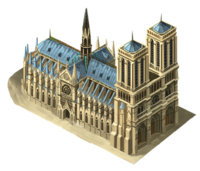
|
Notre-Dame
La cathédrale Notre-Dame de Paris est une église catholique romaine. Construite entre 1163 et 1345, elle est l’une des premières églises gothiques de France. Elle se trouve dans le centre historique de Paris, sur l’île de la Cité (Seine). Le 15 avril 2019, elle a été gravement endommagée par un important incendie. Peu après, le Parlement français a décidé de la reconstruire à l’identique. | |
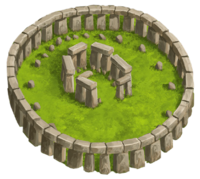
|
Stonehenge
Le monument est une structure mégalithique de la période néolithique. Il est situé près de la rivière Avon, près d’Amesbury, dans le sud de l’Angleterre, et a été érigé en plusieurs sections (sur plusieurs centaines d’années) à partir de 3000 avant J.-C. au moins. Plusieurs hypothèses existent quant à l’origine et à la fonction de ce monument très élaboré. Stonehenge est inscrit au patrimoine mondial de l’UNESCO depuis 1986. | |
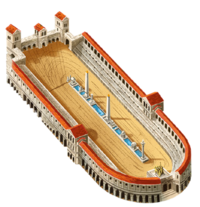
|
Circus Maximus
Construit pour la première fois en pierre en tant qu’installation permanente, la construction a débuté vers 31 avant Jésus-Christ. Avec une longueur totale d’environ 600 mètres et une largeur de 140 mètres, le Circus Maximus était le plus grand cirque de la Rome antique. Il était donc encore plus grand que le Colisée et, jusqu’à l’époque moderne, le plus grand stade du monde. Des courses de chars y ont été organisées jusqu’au VIᵉ siècle. Sa capacité aurait alors atteint 250 000 places, bien que cela ne soit qu’une hypothèse. Il est plus probable qu’il ait compté jusqu’à 150 000 places, ce qui est tout de même déjà très impressionnant. | |
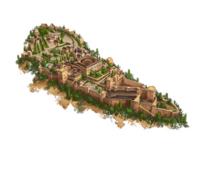
|
Alhambra
Le château de l’Alhambra se dresse sur le plateau de la Sabika à Grenade, en Andalousie (Espagne). Le complexe du château, dans le style mauresque de l’art islamique, mesure environ 740 mètres de long et 220 mètres de large. Les palais nasrides avec leurs jardins, la Médina et le palais de style Renaissance de Charles Quint sont particulièrement importants pour l’Alhambra d’aujourd’hui. L’Alhambra est l’une des attractions touristiques les plus visitées en Europe et a été déclarée site du patrimoine mondial en 1984. | |

|
Abu Simbel
The rock temples in the village of Abu Simbel were built in the 13th century BC. The two temples - the large one for the glory of King (Pharaoh) Ramses II, and the small Hathor-Temple in memory of his wife Nefertari - have been on the UNESCO World Heritage List since 1979. To safe them from the rising waters of Lake Nasser, they were demolished between 1963 and 1968 and rebuilt 64 meters higher on an island in Lake Nasser. | |
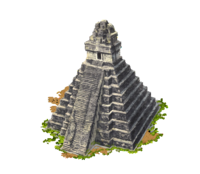
|
Tikal
The ancient Mayan city is best known for its stepped temples. It is located in northern Guatemala, in the rainforests of the Petén and was one of the most important cities in the Classic Mayan period in the 3rd-9th century. Tikal experienced its highlights in the 5th and 8th centuries. Since 2018, researchers have assumed that the area around Tikal was home to at least one million people. The city was completely abandoned by the 10th century at the latest. | |
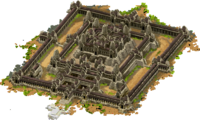
|
Angkor Wat
The most famous temple complex in the Angkor region of Cambodia is located around 240 km northwest of the capital Phnom Penh. When the country south of China developed into a regional center of power in Southeast Asia in the 10th century, the Khmer built large cities and enormous temples. Angkor Wat was built under King Suryavarman II. The complex was built as the king's state temple and was used to worship Vishnu. There is also evidence that it was the mortuary temple of Suryavarman II. | |
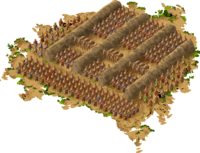
|
Terracotta Army
The so-called Terracotta Army comprises more than 7,000 life-size soldiers. It is part of an early Chinese burial complex, the Qín Shihuángìs Mausoleum. Construction began in 246 BC and Emperor Qín Shihuángìs was buried in it in 210 BC. It is one of the world's largest tombs, one of the greatest archaeological discoveries of the 20th century and has been on the UNESCO World Heritage List since 1987. | |
Historique des règles
- * 09/2024 Rules for Set II updated the Alhambra bonus from 4 points per farmer to 5 points per farmer, and to 6 points per farmer when playing with at least 120 tiles.
Ensemble des tuiles
Série 1
Série 2
Notes
Pour les licences et les explications des icônes, veuillez visiter la page des icônes.
- ↑
 La version initiale des règles proposait de jouer avec plus que les tuiles du jeu de base (environ 90 ou plus) en ajoutant toutes les tuiles que l’on souhaitait (d’autres tuiles du jeu de base ou des extensions mineures, sans appliquer leurs règles).
La version initiale des règles proposait de jouer avec plus que les tuiles du jeu de base (environ 90 ou plus) en ajoutant toutes les tuiles que l’on souhaitait (d’autres tuiles du jeu de base ou des extensions mineures, sans appliquer leurs règles).
- ↑
 Cette phrase est présente dans les règles allemandes de Hans im Glück mais omise dans les règles anglaises.
Cette phrase est présente dans les règles allemandes de Hans im Glück mais omise dans les règles anglaises.
- ↑
 Un meeple placé sur une route est appelé voleur dans la première édition de Carcassonne (C1), brigand dans la deuxième édition (C2) et voyageur dans la troisième édition (C3).
Un meeple placé sur une route est appelé voleur dans la première édition de Carcassonne (C1), brigand dans la deuxième édition (C2) et voyageur dans la troisième édition (C3).
- ↑
 Certaines tuiles Merveille comprennent plusieurs villes réparties sur plusieurs espaces carrés. Chaque espace doit être compté comme une tuile distincte. Les images suivantes illustrent le nombre de tuiles Route et Ville à prendre en compte pour chaque tuile Merveille :
Certaines tuiles Merveille comprennent plusieurs villes réparties sur plusieurs espaces carrés. Chaque espace doit être compté comme une tuile distincte. Les images suivantes illustrent le nombre de tuiles Route et Ville à prendre en compte pour chaque tuile Merveille :

Stonehenge - Une route de deux tuiles qui se divise en deux sections ouvertes (en haut à gauche et au centre)
- Une ville d’une tuile (en haut à droite)
- Deux routes d’une tuile (en bas au centre et à droite)

Notre-Dame - Une route de deux tuiles avec une section ouverte, qui bifurque et se termine sur l’abbaye et sur la merveille (en haut et au milieu).
- Une ville de deux tuiles (en bas à gauche et au centre)
- Une route d’une tuile (en bas à droite)
- ↑
 This sentence was moved to a separate section for the sake of completeness and clarity.
This sentence was moved to a separate section for the sake of completeness and clarity.
- ↑
 Or don't ignore the expansion rules and refer to the Other expansions section of this page for further clarifications from the community. We know what you want.
Or don't ignore the expansion rules and refer to the Other expansions section of this page for further clarifications from the community. We know what you want.
- ↑
 The placement of 1 or 2 wooden meeples as one single action would exclude the possibility of performing any other action in Step 2B-1 (see Order of Play).
The placement of 1 or 2 wooden meeples as one single action would exclude the possibility of performing any other action in Step 2B-1 (see Order of Play).
- ↑ 8.0 8.1
 This is a consequence of a similar official clarification for (haunted) castles and the mist banks on the 2x2 starting tile in
This is a consequence of a similar official clarification for (haunted) castles and the mist banks on the 2x2 starting tile in  Ext. 11 – Fantômes, Châteaux et Cimetières.
Ext. 11 – Fantômes, Châteaux et Cimetières.
- ↑
 This approach is based on the clarifications provided for Les Marchés de Leipzig (see FAQ boxes here).
This approach is based on the clarifications provided for Les Marchés de Leipzig (see FAQ boxes here).
- ↑
 This is a consequence of a similar official clarification for German castles.
This is a consequence of a similar official clarification for German castles.
 Question : If a watchtower scoring for meeples is adjacent to only one half of a double-sized tile, does the watchtower consider those meeples on the half adjacent to the watchtower or all the meeples on the tile?
Question : If a watchtower scoring for meeples is adjacent to only one half of a double-sized tile, does the watchtower consider those meeples on the half adjacent to the watchtower or all the meeples on the tile?
Réponse : The watchtower will consider all the meeples on the double-sized tile. (10/2022)
